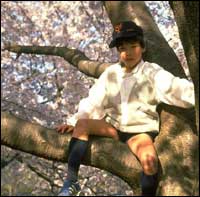
Meet the People
A boy hides out in a tree.
Nagano, Japan, is a city that reflects both Japan's history through thousands of years and its modern economy. The 1998 Olympic Winter Games in Nagano gave millions of people around the world an opportunity to see on television the beautiful mountains and countryside of Japan as well as the country's culture and history. But millions of people each year already see the beauty of Nagano when they visit the Zenkoji Temple, situated on a hill above the city. More than 1,300 years old, it was built to hold the first image of Buddha brought to Japan. It is a very famous and important Buddhist shrine. The temple has traditional Japanese gardens, art, and architecture. Below the temple sits a bustling city that possesses modern skyscrapers and houses and a population of 350,000 people.
![]()

![]()
The students at Shinonoi Nishi Junior High School in Nagano were online guests in February 1998, when the Olympics were held in their city. They felt concern about the environment of their beautiful mountain-filled region, where mountain peaks rise more than 10,000 feet high.
Caring about the environment is an important activity of the school. When a new school building was constructed 32 years ago, many trees were knocked down. So students at the school began a project in recent years to plant new trees. They have planted oak trees, and people at the school now care for the trees in hopes they can regain the lost beauty around the building.
Working to protect the environment was also one of the first projects in which Shinonoi Nishi Junior High students became involved on the Internet. The school has had Internet access since 1995. Students participated in an Internet project about how to keep the world's environment clean. They have communicated online with students in New Zealand, Australia, the United States, and other parts of the world. Learn about life in Japan directly from these students who were interviewed by Scholastic users in 1998.
Daily Life
|